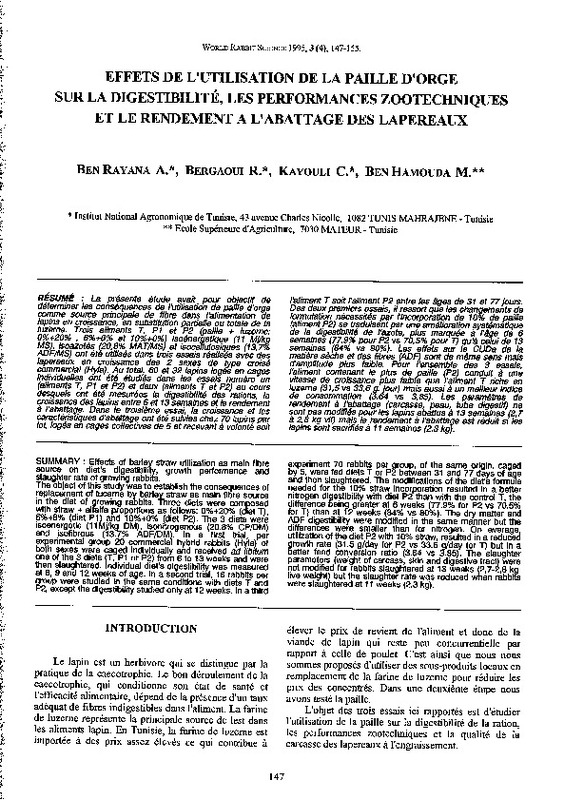JavaScript is disabled for your browser. Some features of this site may not work without it.
Buscar en RiuNet
Listar
Mi cuenta
Estadísticas
Ayuda RiuNet
Admin. UPV
EFFETS DE L'UTILISATION DE LA PAILLE D'ORGE SUR LA DIGESTIBILITÉ, LES PERFORMANCES ZOOTECHNIQUES ET LE RENDEMENT A L'ABATTAGE DES LAPEREAUX
Mostrar el registro sencillo del ítem
Ficheros en el ítem
| dc.contributor.author | Ben Rayana, A.
|
|
| dc.contributor.author | Bergaoui, R.
|
|
| dc.contributor.author | Kayouli, C.
|
|
| dc.contributor.author | Ben Hamouda, M.
|
|
| dc.date.accessioned | 2011-03-21T13:48:40Z | |
| dc.date.available | 2011-03-21T13:48:40Z | |
| dc.date.issued | 1995 | |
| dc.identifier.issn | 1257-5011 | |
| dc.identifier.uri | http://hdl.handle.net/10251/10496 | |
| dc.description.abstract | [EN] Effects of barle~traw utilization as main fibra source on diet's digestibih , growth performance and slaughter rate of growing rabbi . The object of this study was to establish the conseguences of replacement of lucerna by barley straw as main fibra source in the diet of growing rabbits. Three diets were composed with straw + alfalfa proportions as follows: 0%+20% (diet T), 6%+8% (diet P1) and 10%+0% (diet P2). The 3 diets were isoenergetic (11 Mj/kg DM), isonitrogenous (20.8% CP/DM) and isofibrous (13.7% ADFIDMj. In a first trial, per experimental group 20 commercia hybrid rabbits (Hvla) of both sexes were cagad individually and received ad 1ibltum one of the 3 diets (T, P1 or P2) from 6 to 13 weeks and were then slaughtered. Individual diet's digestibility was measured at 6, 9 an(j 12 weeks of age. In a second trial, 16 rabbits per group were studied in the same conditions with diets T and P2, except the digestibility studied only at 12 weeks. In a third experiment 70 rabbits per group, of the same origin, cagad by 5, were fed diets T or P2 between 31 and 77 days of age and then slaughtered. The modifications of the diet's formula needed for the 10% straw incorporation resultad in a better nitrogen digestibility with diet P2 than with the control T, the difference oeing greater at 6 weeks (77.9% for P2 vs 70.5% for TI than at í2 weeks (84% vs 80%). The dry matter and ADF digestibility were modified in the same manner but the differences were smaller than for nitrogen. On average, utilization ofthe diet P2 with 10% straw, resultad in a reduc0cl growth rata (31.5 g/day for P2 vs 33.6 o/day for T) but in a oetter feed conversion ratio (3.64 vs g:85). The sla~hter parameters (weight of carcass, skin and digestiva tract) were not modified for rabbits slaughtered at 13 weeks (2, 7-2,8 kg live weight) but the slaughter rate was reduced when rabbifs were slaughtered at 11 weeks (2.3 kg). | es_ES |
| dc.description.abstract | [FR] La présente étude avait pour ob/ectif de déterminer les conséquences de l'utilisation de pa11Je d'org_e comme source princ1pale de fibre dans J'alimentation Cíe Japins en croissance, en substitution P_!1.rtielle ou totale de la luzerne. Trois aliments T, P1 et P2 (paille + luzerne: 0%+20% , 6%+8% et 10%+0%) isoénergetique (11 Mj/kg MSl, isoazotés (20,8% MAT/MS) et isocel/ulosiques (13,7% ADF/MS) ont éte utilisés dans trois essais réalises avec des Japereaux en croissance des 2 sexes de type croisé commercial (Hyla). Au total, 60 et 32 lapins logés en cages individue/les ont été étudiés dans les essais numéro un (aliments T, P1 et P2) et deux (aliments T et P2) au cours desquels ont été mesurées la digestibilité des rations, la croissance des lapins entre 6 et 13 semaines et le rendement a l'abattage. Dans le troisieme essai, la croissance et les caractéris1iques d'abattage ont été suivies chez 70 lapins par lot, logés en cages collectives de 5 et recevant a volonté soit l'aliment T soit l'aliment P2 entre les A.ges de 31 et 77 jours. Des deux premiers essais, il ressort que les changements de formulation nécessités par l'incorporation de 10% de paille (aliment P2) se traduisent par une amélioration systématique de la digestibilité de /'azote, plus marqués a l'áae de 6 semaines (77,9% pour P2 vs 70,5% pour T} qu'S ce1ui de 13 semaines (84% vs 80%). Les effets sur Je CUDa de la matiere seche et des fibres (ADFJ sont de m§me sens mais d'amplitude plus faible. Pour /'ensemble des 3 essais, l'aliment contenant Je plus de paille (P2) conduit a une vitesse de croissance plus faible que l'allment T riche en Juzerne (31,5 vs 33,6 g. /our) mais aussi a un meilleur indice de consommation (3,64 vs 3,85). Les parametres de rendement a l'abattage (carcasse, peau, tube digestif) ne sont pas modifiés pour les Japins abattus a 13 semaines f2, 7 a 2,8 kg vif) mais le rendement a l'abattage est réduit s1 les lapins sont sacrifiés a 11 semaines (2.3 kg). | |
| dc.language | Francés | es_ES |
| dc.publisher | World Rabbit Science. ICTA. UPV | es_ES |
| dc.relation.ispartof | World Rabbit Science | |
| dc.rights | Reserva de todos los derechos | es_ES |
| dc.title | EFFETS DE L'UTILISATION DE LA PAILLE D'ORGE SUR LA DIGESTIBILITÉ, LES PERFORMANCES ZOOTECHNIQUES ET LE RENDEMENT A L'ABATTAGE DES LAPEREAUX | es_ES |
| dc.type | Artículo | es_ES |
| dc.date.updated | 2011-03-21T13:36:05Z | |
| dc.identifier.doi | 10.4995/wrs.1995.255 | |
| dc.rights.accessRights | Abierto | es_ES |
| dc.description.bibliographicCitation | Ben Rayana, A.; Bergaoui, R.; Kayouli, C.; Ben Hamouda, M. (1995). EFFETS DE L'UTILISATION DE LA PAILLE D'ORGE SUR LA DIGESTIBILITÉ, LES PERFORMANCES ZOOTECHNIQUES ET LE RENDEMENT A L'ABATTAGE DES LAPEREAUX. World Rabbit Science. 3(4). https://doi.org/10.4995/wrs.1995.255 | es_ES |
| dc.description.accrualMethod | SWORD | es_ES |
| dc.relation.publisherversion | https://doi.org/10.4995/wrs.1995.255 | |
| dc.description.volume | 3 | |
| dc.description.issue | 4 | |
| dc.identifier.eissn | 1989-8886 | es_ES |








